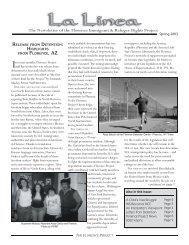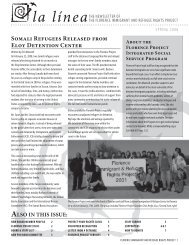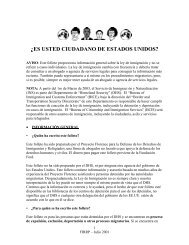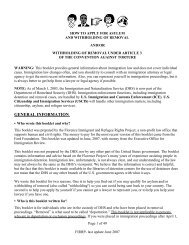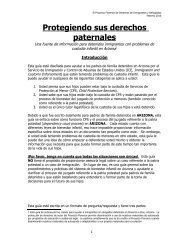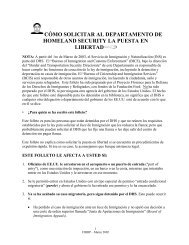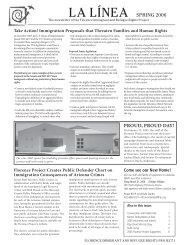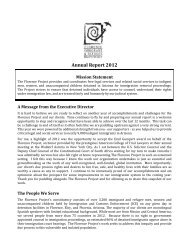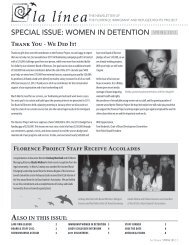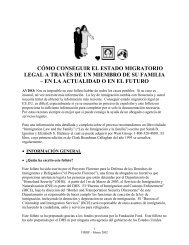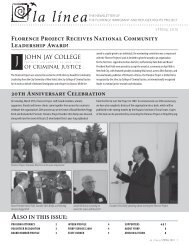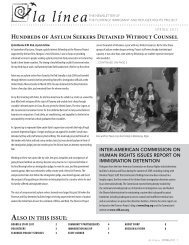quick reference chart and annotations for determining immigration ...
quick reference chart and annotations for determining immigration ...
quick reference chart and annotations for determining immigration ...
Create successful ePaper yourself
Turn your PDF publications into a flip-book with our unique Google optimized e-Paper software.
Immigrant Legal Resource Center, Florence Immigrant <strong>and</strong> Refugee Rights Project,<br />
Maricopa County Public Defender August 2012<br />
A. A person commits theft by extortion by knowingly obtaining or seeking to obtain property or services<br />
by means of a threat to do in the future any of the following:<br />
1. Cause physical injury to anyone by means of a deadly weapon or dangerous instrument.<br />
2. Cause physical injury to anyone except as provided in paragraph 1 of this subsection.<br />
3. Cause damage to property.<br />
4. Engage in other conduct constituting an offense.<br />
5. Accuse anyone of a crime or bring criminal charges against anyone.<br />
6. Expose a secret or an asserted fact, whether true or false, tending to subject anyone to hatred, contempt<br />
or ridicule or to impair the person's credit or business.<br />
7. Take or withhold action as a public servant or cause a public servant to take or withhold action.<br />
8. Cause anyone to part with any property…<br />
C. Theft by extortion as defined in subsection A, paragraph 1 is a class 2 felony. Otherwise, theft by<br />
extortion is a class 4 felony.<br />
Crime Involving Moral Turpitude (CMT): Counsel should assume that <strong>immigration</strong> judges<br />
will hold that a conviction under § 13-1804 constitutes a crime involving moral turpitude. See, e.g.,<br />
Matter of GT, 4 I&N Dec. 446 (BIA 1951) (sending threatening letters with intention to extort is a CMT).<br />
However, <strong>immigration</strong> attorneys at least may have good arguments that some subsections are not CMTs.<br />
Extortion is defined in Black’s Law Dictionary, as “the act or practice of obtaining something or<br />
compelling some action by illegal means, as by <strong>for</strong>ce or coercion” (7th Ed) (emphasis added). Sections<br />
A5, A6, <strong>and</strong> A7 do not necessarily involve “illegal means”; however, an <strong>immigration</strong> judge may still<br />
conclude that such conduct is a CMT as “inherently base, vile, or depraved.” Matter of Danesh, 19 I&N<br />
Dec. 669, 670 (BIA 1988).<br />
Aggravated Felony: Theft. Counsel should assume conservatively that theft by extortion will be<br />
held to constitute a taking without consent, <strong>and</strong> there<strong>for</strong>e may be an aggravated felony as theft if a<br />
sentence of a year or more is imposed. See discussion of Theft, above. To prevent this, counsel should<br />
leave the record of conviction vague between theft of property <strong>and</strong> services, or designate services. Theft<br />
is defined as “a taking of property or an exercise of control over property without consent with the<br />
criminal intent to deprive the owner or rights <strong>and</strong> benefits of ownership, even if such deprivation is less<br />
than total or permanent.” U.S. v. Corona-Sanchez, 291 F.3d 1201, 1205 (9th Cir. 2002) (emphasis<br />
added).<br />
Crime of violence. The offense also may be an aggravated felony as a crime of violence if a<br />
sentence of at least a year is imposed. A “crime of violence” involves the use, attempted use, or<br />
threatened use of physical <strong>for</strong>ce against the person or property of another. 18 U.S.C. § 16(a). Counsel<br />
should assume that a conviction under A1, A2, or perhaps A3, or where the record shows use or threat of<br />
<strong>for</strong>ce, is likely to be an aggravated felony if a sentence of a year or more is imposed<br />
44. Shoplifting, ARS § 13-1805<br />
A. A person commits shoplifting if, while in an establishment in which merch<strong>and</strong>ise is displayed <strong>for</strong> sale,<br />
the person knowingly obtains such goods of another with the intent to deprive that person of such goods<br />
by:<br />
1. Removing any of the goods from the immediate display or from any other place within the<br />
establishment without paying the purchase price; or<br />
2. Charging the purchase price of the goods to a fictitious person or any person without that person's<br />
authority; or<br />
Arizona Criminal Chart with Explanatory Endnote – August 2012<br />
58



